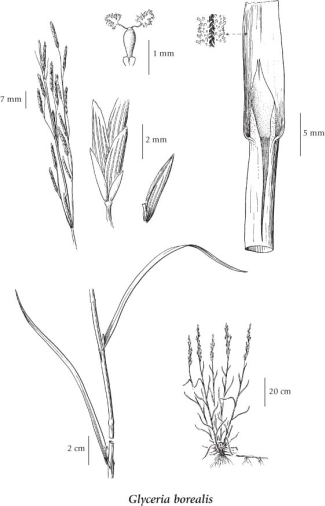Glyceria borealis (Nash) Batchelder
northern mannagrass (small floating mannagrass)
Poaceae (Grass family)
Introduction to Vascular Plants
northern mannagrass (small floating mannagrass)
Poaceae (Grass family)
Introduction to Vascular Plants
Species Information
General:
Perennial grass from conspicuous rhizomes, freely rooting; stems erect to more or less decumbent, hollow, 80-150 cm tall/long.
Leaves:
Sheaths somewhat flattened, smooth, open for 1-4 cm; blades (2) 3-5 (6) mm wide, flat or folded, more or less pimpled on the upper surfaces; ligules pointed, entire but usually splitting, minutely hairy, (4) 5-10 mm long.
Flowers:
Inflorescence a narrow panicle, 18-50 cm long, the branches ascending-appressed; spikelets mostly 6- to 11-flowered, linear, tapered at the tips, 10-12 (15) mm long; lower glumes (1.5) 2-2.5 mm long, the upper ones slightly over 3 mm long; lemmas prominently 7-nerved to the narrow, translucent upper margins, 3-4 mm long, smooth, minutely rough on the nerves; stamens 3; anthers 0.5-1 mm long.
Illustration

If more than one illustration is available for a species (e.g., separate illustrations were provided for two subspecies) then links to the separate images will be provided below. Note that individual subspecies or varietal illustrations are not always available.
Illustration Source: The Illustrated Flora of British Columbia
USDA Species Characteristics
Flower Colour:
Green
Blooming Period:
Late Spring
Fruit/Seed characteristics:
Colour: Yellow
Present from Spring to Summer
Source: The USDA
Ecology
Ecological Framework for Glyceria borealis
The table below shows the species-specific information calculated from
original data (BEC database) provided by the BC Ministry of Forests and Range.
(Updated August, 2013)
The table below shows the species-specific information calculated from
original data (BEC database) provided by the BC Ministry of Forests and Range.
(Updated August, 2013)
| Site Information |
Value / Class |
||
|
Avg |
Min |
Max |
|
| Elevation
(metres) |
960 | 130 | 1655 |
| Slope
Gradient (%) |
0 | 0 | 14 |
|
Aspect (degrees) |
106 | 20 | 171 |
| Soil
Moisture Regime (SMR) [0 - very xeric; 4 - mesic; 8 - hydric] |
7 | 5 | 8 |
| Modal
Nutrient Regime
Class |
D | ||
| #
of field plots species was recorded in: |
49 | ||
| Modal
BEC Zone Class |
IDF | ||
|
All BEC Zones (# of stations/zone) species was recorded in |
CDF(10), CWH(3), ESSF(2), ICH(2), IDF(17), MS(1), PP(1), SBPS(6), SBS(7) | ||
|
Source:
Klinkenberg 2013
|
|||
Habitat and Range
Swamps, lakeshores and wet meadows (often in water up to 1 m deep) in the lowland and montane zones; frequent in SW BC, infrequent in SC BC; N to AK and YT, E to NF and S to ME, MA, PA, IN, IA, SD, NM, AZ and CA.Status Information
Synonyms
Synonyms and Alternate Names:
Panicularia borealis Nash